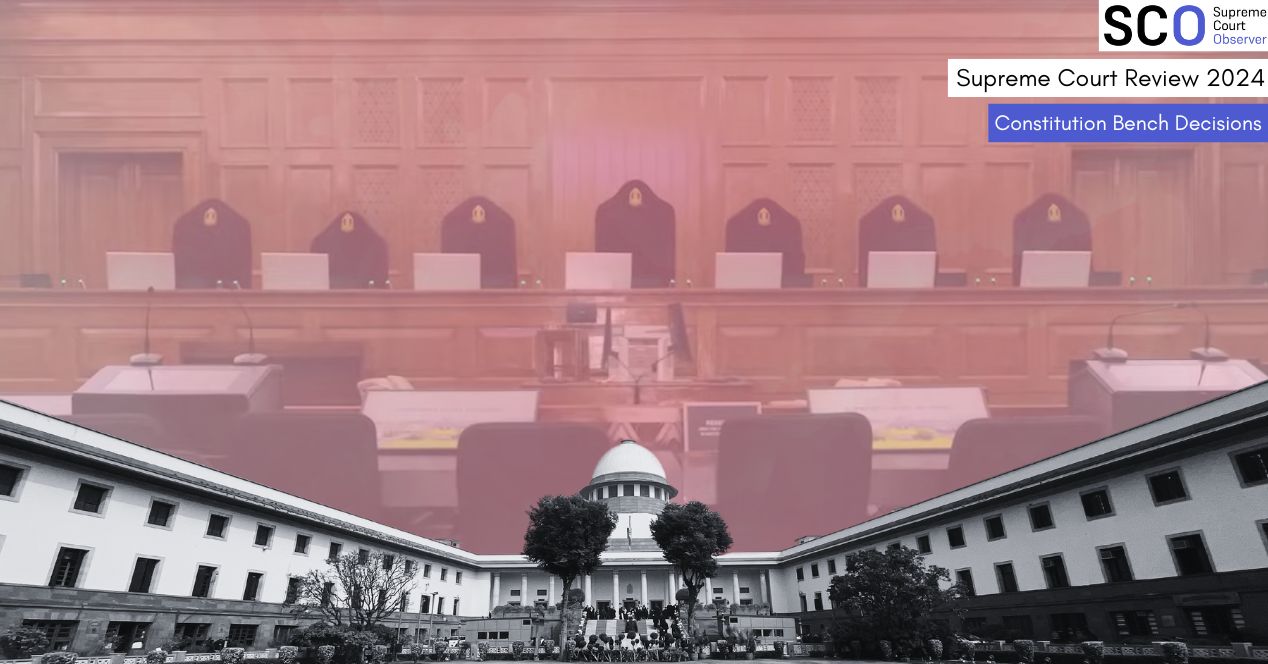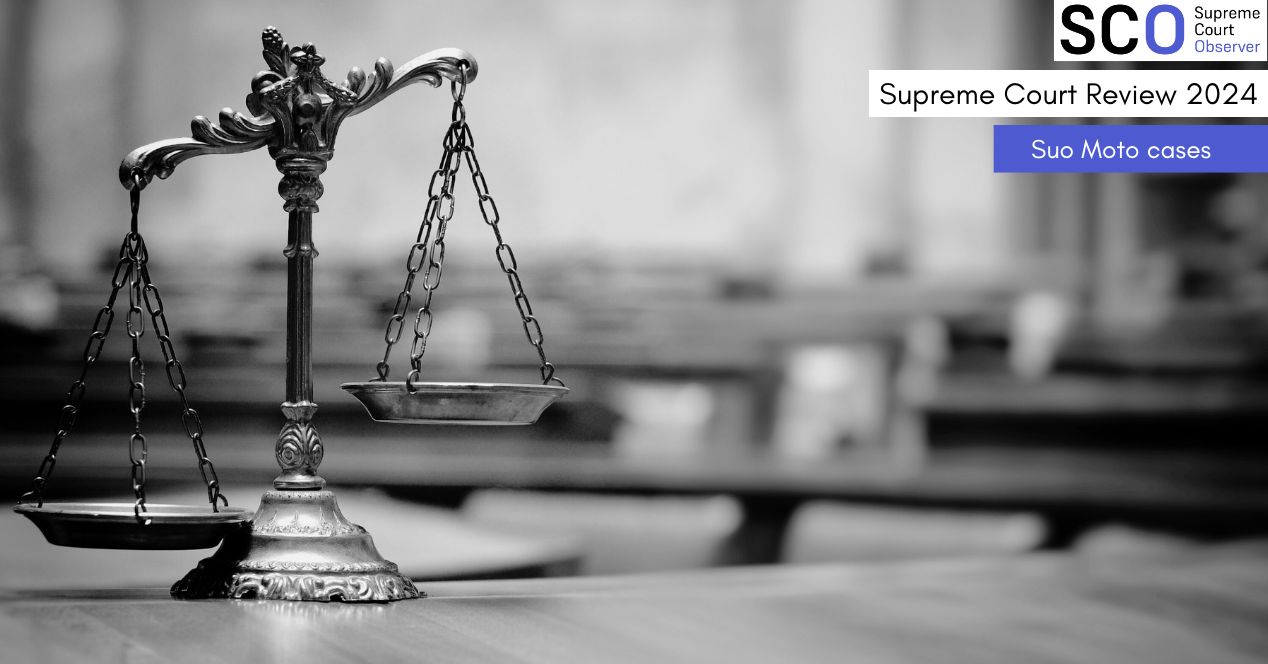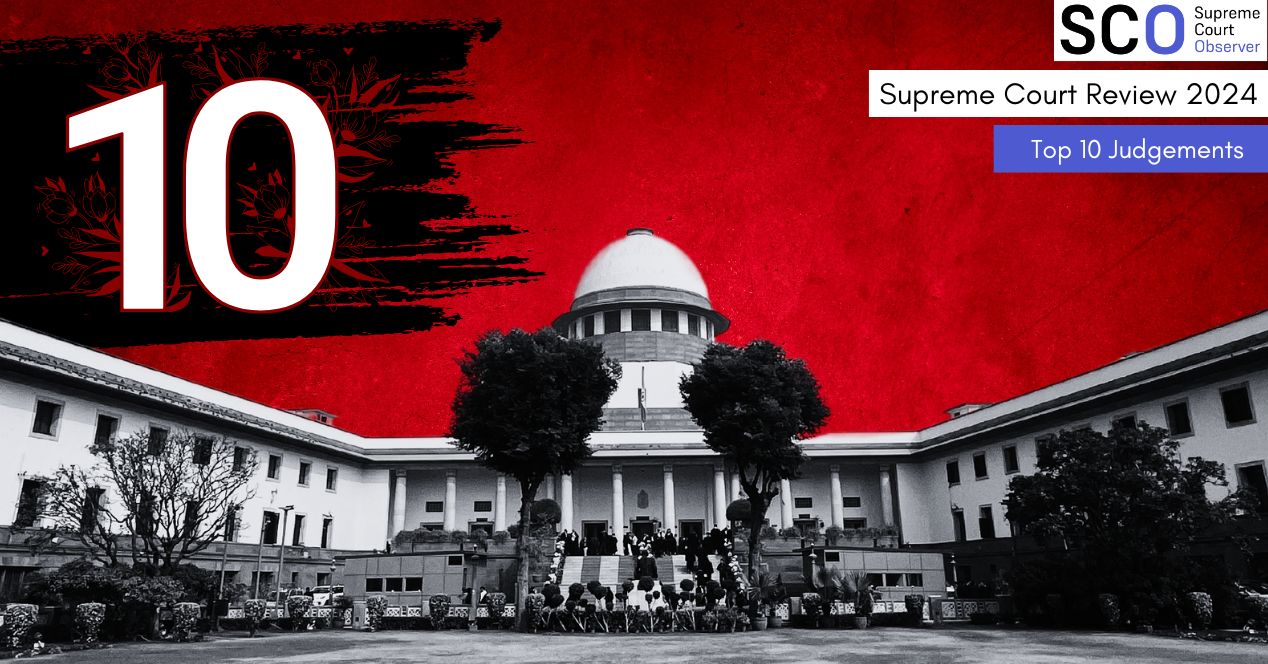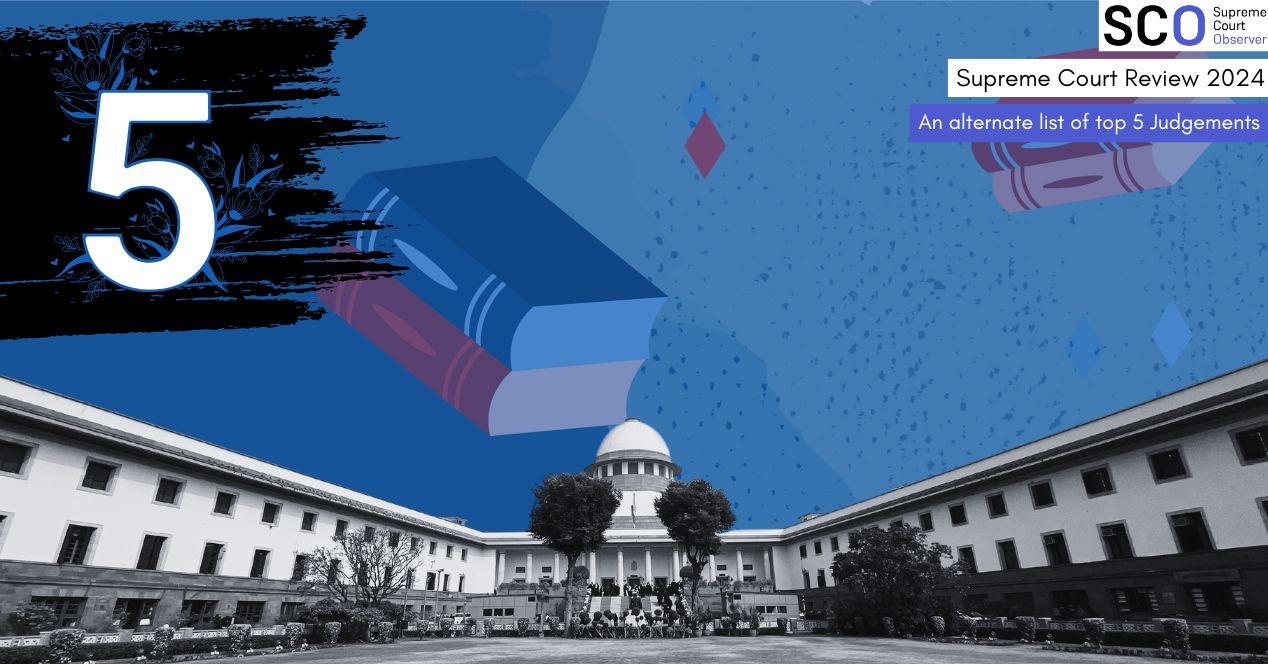Court Data
Supreme Court Review 2024: A steady recovery in pendency after the pandemic years
83,000 pending cases is a large number but a high disposal rate points to a busy Court’s concerted efforts to tackle pendency
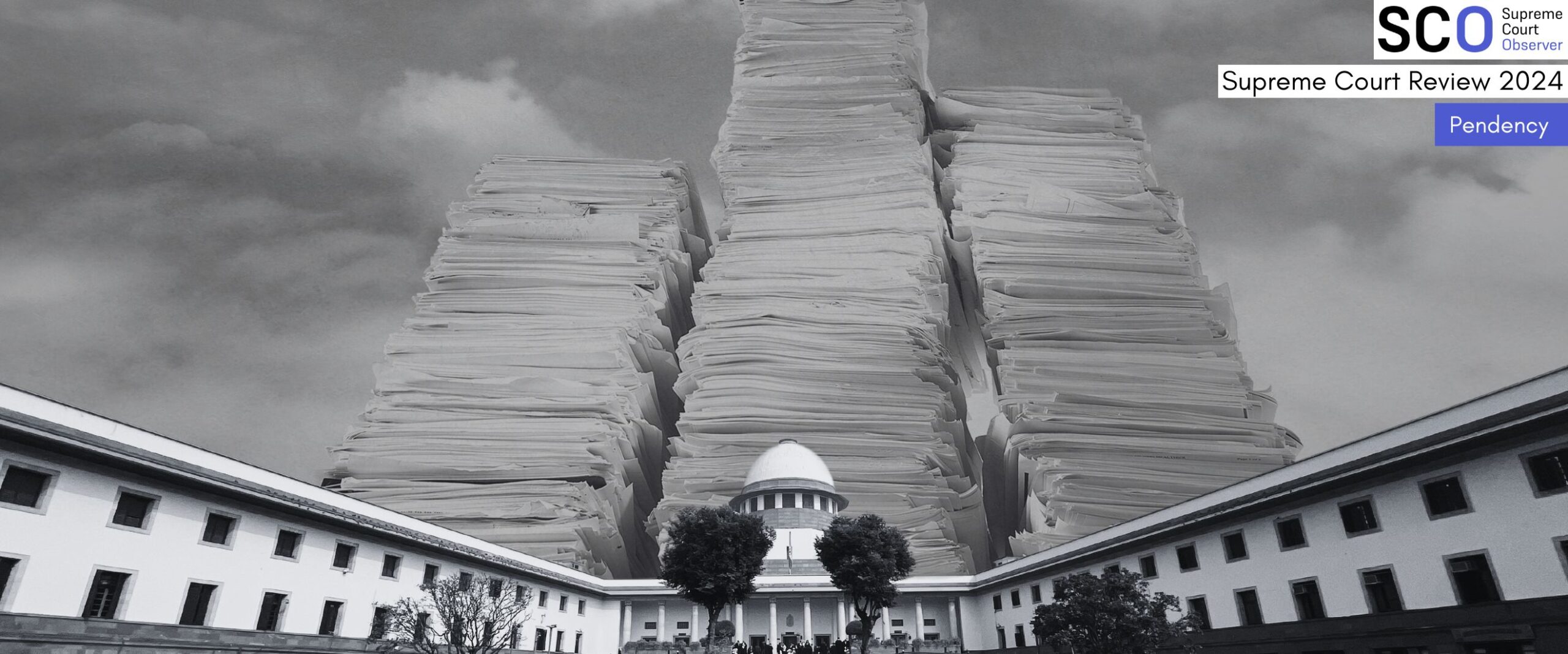
“Though the pendency has swelled enormously in the past three years due to Covid-19, the Apex Court has endeavoured to hear as many matters as could be possible during the post Covid period,” the Supreme Court assured in its latest Annual Report.
At a first glance of Figure 1 below, which plots the number of pending cases at the end of each of the last 10 years, this may not look true. The pendency figure skyrocketed by almost 20,000 from 2019 to 2022. The upward trend continued to hold in 2023 and 2024.
But the rate of growth slowed down in 2023, the first full year since 2020 when the Court’s functioning was not impeded by the pandemic. In our 2023 pendency review, we had struck a tone of hope: while the yearly increase in pendency in the years from 2019 through to 2022 averaged around 5000 cases, the jump from 2022 to 2023 was less than 2000. The rate of increase stayed steady last year: 2024 closed with about 2300 more pending cases than 2023.
A key consideration is assessing these numbers is the change in counting methodology. When CJI D.Y. Chandrachud took oath as Chief Justice in November 2022, he introduced an adjustment in the selection of cases categorised by the Court as pending. The Court’s Annual Report that year explained that “the data from November 2022 onwards includes all diarised matters which also includes Miscellaneous Applications, Unregistered Matters, Defective matters etc.”
The result was the sharp uptick in the number of pending cases from 2021 to 2022—from 70,239 to 78,797. The increase by 8,558 (the highest in the last decade) could be explained by the inclusion of cases that would be dealt with by the Registry, without ever being listed for full hearing before a bench of the Court. Such cases—which may have filing defects or be otherwise unregistered—were not previously accounted for in the pendency figures though they were a key contributor to the congestion in the Court’s docket.
In this context, the increase in pendency by a little over 2000 cases in 2024 appears reasonable. This can further be examined by looking closely at the Court’s work in the last year. To do this, we worked with two sets of data.
How we’ve collected the pendency, institution and disposal data
In September 2023, institution and disposal data from the Supreme Court began showing on the National Judicial Data Grid (NJDG) portal, which was already hosting data from the High Court and district court levels. Given this shift, the Supreme Court ceased its periodic publication of month-end data. The Court’s new website, which was launched in January 2024, does not have a dedicated page for month-wise pendency data.
For our month-wise data articles in the Court Data section on our website, we began to collect the pendency numbers recorded on the NJDG at the end of every month (the frequency with which data is updated on the NJDG remains indeterminate). Our articles record the NJDG pendency figures and the data on institution and disposal of cases for every month.
The Supreme Court’s Annual Report for 2023-24 contains the official pendency figures but only until August 2024. SCO’s record of NJDG figures for the remaining months makes this, at the time of publication, perhaps the only publicly available dataset that accounts for the whole year at a month-wise level.
Figure 2 below plots the number of pending cases at the end of each month in 2024.
Last year was also unusually busy with Constitution Bench (CB) activity—a total of 34 days of hearing and 12 judgements. Each CB case asks a substantive question of law or requires the court to interpret the Constitution. Often, these hearings take up the entire day for that bench, shifting their focus from the many other cases they could have heard and cleared that day.
However, CB decisions contribute towards tackling pendency in other ways. There are many cases that raise similar questions of law as the ones raised in CBs—they remain pending until the CB is decided. These cases are often tagged to the main CB case, and get disposed of together. For instance, the NJDG shows that three nine-judge bench cases are currently pending. If these three cases are cleared, the 69 tagged with them will also be disposed of. It also means that similar but untagged cases that remained pending due to lack of clarity on the position of law can now be cleared by the Court. In the brief month-wise summary below, we have noted key Constitution Bench activity.
In January 2024, the Court reduced its pendency by 866 cases, the second biggest drop in the year. The Court worked for 20 days, with 33 judges. On 25 January, the court regained its full strength with the appointment of Justice P.B. Varale. Seven judges were occupied with the question of Aligarh Muslim University’s minority status for seven days.
Pendency was at its lowest in February, as the Court managed to reduce the pile by 459 cases over 21 working days. The reduction in pendency was particularly impressive as this was the month the Court heard Constitution Bench cases with five, seven and nine judges. Over three days each, the Court heard challenges to sub-classification in reserved categories (five judges) and the taxation of minerals and mines by states (nine judges). It also heard the challenge to the minority status of Aligarh Muslim University (seven judges) for one day.
In March, there were only 15 working days on account of the Holi break. Pendency rose by 805 cases, bringing the total figure to over 80,000 cases. The number of pending cases did not fall below this mark for the rest of the year. A nine-judge Constitution Bench heard arguments on the states power to tax mines and minerals for five of these days.
The Court worked for 19 days in April and pendency continued to go up, this time by 370 cases. For 10 of these days, nine-judge Constitution Benches were occupied in hearing arguments on states’ power to regulate industrial alcohol and whether private property is a “material resource of the community”. Justice Aniruddha Bose retired on 10 April, bringing the sitting strength of the Court to 33 judges.
By May, pendency increased steeply by 1486 cases. The Court worked for just 13 days and began its seven-week summer vacation on 20 May 2024. The hearings on the rights of private property owners continued for another day. On the last working day, Justice A.S. Bopanna retired, bringing the sitting strength of the Supreme Court to 32 judges.
A record high of 20 Vacation Benches were sitting with two or three judges throughout the summer break. The Registry announced that 4160 cases were listed before these benches—significantly more than the preceding years. Despite these Vacation Benches clearing more than 1000 cases, pendency shot up by 1904 cases in June, leading to the year’s highest pendency figure: 83,914.
The Court returned from the summer break on 7 July with renewed vigour. The reduction of pending cases by 1437 was the biggest drop all year. The Court worked 17 days that month. On 28 July, two new judges joined the Supreme Court: Justices N.K. Singh and R. Mahadevan. With this, the court reached a full sanctioned strength of 34 judges.
In August, the Court had 18 working days and reduced pendency by 141. Five judges spent three days hearing arguments on the unilateral appointment of arbitrators.
September saw an uptick in pendency by 764 cases even though the Court was functioning with full strength through 20 working days.
In October, pendency fell by 99 cases though there were only 13 working days on account of the Diwali and Dussehra vacations.
November saw a drop in pendency by 654 cases, the third biggest in the year. This was the month that the incumbent Chief Justice Sanjiv Khanna took oath. In the days that followed, he announced that regular matters (where the Court hears arguments on merits), will not be heard until further notice. This move created a chatter, with many unsure of how it would affect pendency. We know from the Supreme Court’s Annual Reports that cases at the admission stage constitute a large chunk of the case docket. The drop in pendency is likely to have been a result of this move. However, this was also the month that saw five Constitution Bench judgements including the ones on the nature of private property, the validity of ‘light motor vehicle’ licence to drive a ‘transport vehicle’, altering rules for appointment to public posts, Aligarh Muslim University’s minority status and the unilateral appointment of arbitrators.
In December, the Supreme Court worked for 15 days before it closed for the winter vacation. As per the data collected from the NJDG on 31 December 2024, the number of pending cases stood at 82,972.
The big picture
Pendency numbers are best contextualised against the number of cases instituted. Take July, for instance. We know that this is the month that saw the biggest reduction in pendency. Institution data suggests that this was also the month that the number of cases filed in the Supreme Court shot up by over 2500. So, to have made such a significant dent to pendency, the Court had to dispose of far more cases than it does on average.
It helps to see how much the rate of increase in institution influences the pendency figure. In other words, the Court could have a brisk rate of disposal and a high pendency number. This year, we see that the Court has maintained an impressive disposal rate of about 4800 cases a month, compared to 4329 cases in 2023 and 3316 cases in 2022. The Court disposed of 57,972 cases in total in 2024.
In contrast, we see that the number of cases filed in 2024 was over 61,000. The high number of pending cases, therefore, can be attributed to the inordinately high number of cases that reach the Supreme Court.
Looking ahead
When CJI Chandrachud retired in November 2024, we had written about his claims of having made strides in tackling the persistent pendency problem. Our Report Card showed that his claim was fair in many ways—the technological and logistical changes he introduced had yielded noticeable results in a system which receives tens of thousands of cases every year.
However, CJI Chandrachud’s tenure of two years was unusual for its duration. He seemed to have had the time to introduce, implement and even finetune the changes he brought about. Successive CJIs do not have that luxury. CJI Khanna has only six months. Justice Gavai after him will have fewer.
Concerted efforts are needed to go beyond maintaining current levels of pendency and make a meaningful dent in the number. We are yet to see if Justices Khanna, Gavai and Surya Kant will be able to work together towards this goal. Disjointed efforts will likely choke the Court’s functioning, causing pendency to reach new and unwanted highs in 2025.

